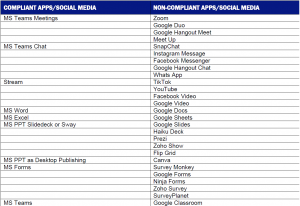Link to resource: Assessment Research, Resources and Rationale
Assessment is a crucial component of learning used in both K-12 and post-secondary education. In order to support other educators, we wanted to examine assessment through the lens of an online learning environment. Assessment is meant to focus on “student involvement and authentic, meaningful assessment, leading to the development of a variety of assessment forms” (Weurlanderet al., 2012). Quality assessment requires knowledge of provincial curriculum frameworks, district vision and goals, as well as teachers’ expertise with traditional and online tools to support it. Furthermore, there is an emphasis on competence-based curriculum focusing on “capability rather than factual knowledge” (Weurlanderet al., 2012). The resources we curated as well as the resources we created are supported by research and support our learning outcomes.
Formative and summative assessment are vital aspects of all learning environments. Formative assessment informs teachers of students ongoing learning and understanding, whereas summative is a final capturing of students overall learning. According to Weurlander et al. (2012) formative assessment can influence “students’ learning in a number of ways. It sends messages about what counts as important knowledge; it has an impact on students’ approach to learning and gives feedback to students about their learning” (p. 749). Additionally, they included research that found formative assessment “positive[ly] impact[s] student learning” (p. 749). When considering or creating assessment, it is important to include a variety of “assessment tasks [as they] have the potential to support student learning in different ways” (p.758). Moreover, a multitude of assessment strategies, including collaborative and blended learning approaches, increases student engagement (Vaughan, 2014).
Summative assessment is meant to be a final snapshot of students learning. However, it can exclude learners or create anxiety when the stakes are high for a singular assessment for both in-person and online learning environments states that,
“[h]igh– stakes tests are inevitably designed to be as ‘objective’ as possible, since there is a premium on reliable marking in the interests of fairness. This has the effect of reducing what is assessed to what can be readily and reliably marked. Generally, this excludes many worthwhile outcomes of education such as problem-solving and critical thinking” (p. 209).
Another concern about high-stakes summative assessments is that they may encourage cheating, a pressing concern for teachers, particularly in an online environment (Mellar et at.,2018). Creating a variety of authentic summative assessments and giving students choice can help to ensure their validity (Mellar et al., 2018). Therefore, it is imperative that students are provided with a variety of summative assessments with low stakes when teaching online.
When integrating formative and summative assessment strategies, teachers should consider the quantity, as creating too many assessments to track student progress can have a negative impact (Vaughan, 2014). This also restricts teachers from providing timely feedback to their students, a key component of successful online learning (Gaytan and Mcewen, 2007). “Feedback is therefore a key component in formative assessment, and students need to understand and be able to act on the feedback they receive in order to improve their learning” (Black and Wiliam 1998; Nicol and Macfarlane-Dick 2006; Sadler 1989, 1998; as cited in Weurlander et al.,2012., p. 748). Furthermore, Shea and Bidjerano (2010) discovered that teaching presence along with teaching students the technological skills they need to complete and navigate given tasks leads to “successful online learning” (p. 1727). Thus, well planned online learning experiences along with feedback, help and encouragement also improves learning success for at risk learners (Hughes, 2007).
In conclusion, when considering online or in-person teaching environments, summative and formative assessments are vital. Formative assessment should be used to continually check in with students about their understanding of content, leading into a summative review of their learning. When assessing students, a variety of tools and strategies should be used in order to reach all learners for both types of assessments. Overall, the focus of this project was to provide teachers with a realistic and comprehensive overview of what assessment in classroom and online environments could entail.
Co-Authored by Faune Nicholas, Jerry Chien, Leanne Huston, and Rochelle Smith
References
- Gaytan, J., & Mcewen, B. C. (2007). Effective Online Instructional and Assessment Strategies. American Journal of Distance Education, 21(3), 117–132. https://doi.org/10.1080/08923640701341653
- Harlen, W. (2005). Teachers’ summative practices and assessment for learning – tensions and synergies. The Curriculum Journal, 16(2), 207–223. https://doi.org/10.1080/09585170500136093
- Hughes, G. (2007). Using blended learning to increase learner support and improve retention. Teaching in Higher Education, 12(3), 349-363. https://www.tandfonline.com/doi/abs/10.1080/13562510701278690
- Mellar, H., Peytcheva-Forsyth, R., Kocdar, S., Karadeniz, A., & Yovkova, B. (2018). Addressing cheating in e-assessment using student authentication and authorship checking systems: teachers’ perspectives. International Journal for Educational Integrity, 14(1). https://doi.org/10.1007/s40979-018-0025-x
- Shea, P., & Bidjerano, T. (2010). Learning presence: Towards a theory of self-efficacy, self-regulation, and the development of a communities of inquiry in online and blended learning environments. Computers & Education, 55(4), 1721–1731. https://doi.org/10.1016/j.compedu.2010.07.017
- Vaughan, N. (2014). Student Engagement and Blended Learning: Making the Assessment Connection. Education Sciences, 4(4), 247–264. https://doi.org/10.3390/educsci4040247
- Weurlander, W., & Soderberg, M., & Scheja, M., & Hakan, H., & Wernerson, A., (2012). Exploring formative assessment as a tool for learning: students’ experiences of different methods of formative assessment. Assessment & Evaluation in Higher Education. 37.(6). 747-760, DOI: 10.1080/02602938.2011.572153









